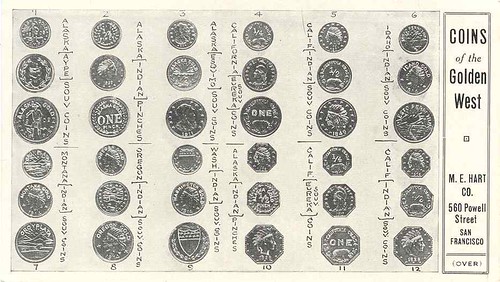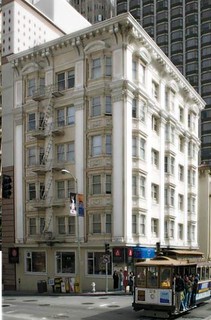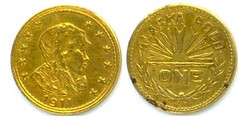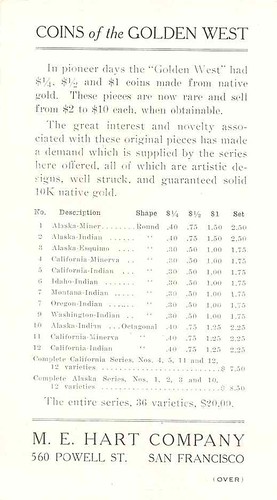
PREV ARTICLE
NEXT ARTICLE
FULL ISSUE
PREV FULL ISSUE
WILL THE REAL M.E. HART PLEASE STAND UP? PART 1Mike Locke and Dan Owens write: The following draft (in two parts) is a research paper on the M.E. Hart Co. without a definitive conclusion. We are asking readers of The E-Sylum for their help in solving this mystery. If you come across any M.E. Hart Co. advertisements, Shreve & Co. employee records from 1915-1916, or contemporary numismatic publications that reveal the namesake or provide additional information regarding the M.E. Hart Co., we request that you publish your findings in The E-Sylum, or send them to us via the email link on www.calgoldcoin.com. Thanks in advance for your assistance. Mike Locke and Dan Owens
Here's part one. We broke it up because it's just too long for a single article. But I think readers will find it interesting,
and perhaps someone can help. -Editor

Mike Locke and Dan Owens research paper, compiled by Dan Owens. Between the pages of history surrounding the world renowned Panama Pacific International Exposition held in San Francisco in 1915, the identity of M.E. Hart was lost to the collecting world. Hart is best known in numismatic circles for marketing Coins of the Golden West and selling official souvenirs from the Exposition, circa 1915-1916. Hart's business address was 560 Powell street site of the Chesterfield Apartments in San Francisco.
We then turned our attention to the Panama Pacific International Exposition. We located an article entitled Numismatics at the Panama Pacific International Exposition which appeared in the April 1916 issue of B. Max Mehl's Numismatic Monthly. A subsequent follow-up with librarian David Hill at the American Numismatic Society revealed that this article contained no useful clues to Hart's identity. However, Locke thumbed through some of his scattered issues of Mehl's Coin Circular and discovered that in 1922, the well-known numismatist and coin dealer, had offered one of Hart's cased sets for sale for $25. Mehl did not express any knowledge of M.E. Hart, nor did he note the M.E. Hart label on the back of the set. Mehl's apparent lack of knowledge regarding Hart only deepened the mystery surrounding his or her identity since he had attended the 1915 Panama Pacific Exposition and American Numismatic Association convention in San Francisco and apparently immersed himself in everything of a numismatic nature. Thus we decided to cast a wide net into a sea of potential suspects with or without the last name of Hart. Following all available leads, four candidates would eventually emerge from the shadows of history. Candidate No. 1
Zerbe had also purchased the remaining stock of the Panama Pacific silver half dollar commemorative coins. Thus it was his modus operandi to exhibit similar behavior to that of the M.E. Hart Co.
I then asked Locke if he had ever seen Zerbe make a contemporary acknowledgement of the Coins of the Golden West set. He stated that he had and sent me an e-mail with a transcribed article entitled The Government's Attention to “Gold Charms” which appeared in the August 1919, edition of The Numismatist. In this piece, Zerbe had addressed the concerns and crackdown by the U.S. Government over the sale of gold tokens or charms and the misuse of them by vendors who preyed on tourists exchanging a stamped dollars worth of tokens for a dollars worth of U.S. currency. In reality most tokens contained only 40% or less of their face value. He then made a note to defend the quality of the Coins of the Golden West set with the following: “While mostly made stamped as of “California”, there have been many made naming other localities. Several series have an Alaska stamp, and the production of one maker that has been marketed as a set under the name “Coins of the Golden West,” said to be the best die work and composition quality of any marketed in recent years, contains thirty-six varieties, with stampings not only for California and Alaska, but also for Washington, Oregon, Montana and Idaho...” Was the preceding statement a weak attempt by Zerbe to justify his past sales? Candidate No. 2
She was the Special Agent, Department of the Interior for Education, Art and Woman's Work, in charge of the Alaska exhibit at the Alaska Yukon Pacific Exposition held in Seattle in 1909. Through a series of newspaper and bulletin articles spread out over several years, we were able to glean some insight into Mrs. Hart's personality and character. On August 1st of 1909, the Seattle Sunday Times, published an article that she wrote entitled Alaska Gold Camps Bow To Fair Women. Mary opened her piece with the following quote, “They talk about a woman's sphere, as though it had a limit. There's not a happening on earth that bears a feather's weight of worth, without a woman in it.” Mrs. Hart took her role as a journalist very seriously. In 1911, she lost two years worth of text when her unpublished manuscript A Handbook of Alaska, was destroyed by water damage in the pile up of the steamship Spokane in Seymour Narrows. According to the July 21st, 1911 Daily Alaska Dispatch, Hart was the last woman to leave the vessel. In 1914, she told a writer in her home state of Missouri, that she once had an assignment for an article about the “Reindeer Queen” Sinrock Mary. To complete her work, Mrs. Hart rode forty miles in an open boat made of walrus hide. Her guides were natives who had just traded pelts for whisky and were in her words “liquor crazy”. After landing, a dog sled ride of fifteen miles was required to bring her to the native village. She was quoted as saying, “I got my story, but I felt it was a pretty close call.” Also in 1914, when she was vice-president of the Pacific Coast Women's Press Association, she spoke on being “A Woman Journalist in the Far North.” The Alaska editor, as a rule is not the proverbial “poor man,” and his subscriptions are never paid in potatoes, pumpkins and other garden truck, as is sometimes the experience of the country editor in “the states.” On the contrary, in the early days, I have often seen subscriptions paid in gold dust, and the Alaska editor has a chance to “be in on the ground floor,” in every new strike, and secure good holdings along with the best of the experienced “sourdough miner,” because they trust him, and are not averse to letting him in on a good thing when new “pay dirt” is struck. There is something about the spirit of the North that inspires the artist, poet, and the writer of fiction...I too have felt this inspiration, and the longing to return to the quiet and the peace-the “Great White Silence” of our Arctic winter. Hart also represented the Alaska Cruise Club at the 1915 Panama Pacific International Exposition in San Francisco. She traveled through-out Alaska gathering materials for the display and received a gold medal from the Expo for putting together and hosting the Pacific Mail Steamship Co.'s Alaska Cruise Club exhibit. Mary proudly represented Alaska at a women's suffrage rally held at the Expo. In a newspaper article that went national dated San Francisco July 15th, 1915, Mrs. Hart when asked what are the chances for women in Alaska? responded by stating “Why, bless your heart-yes! Lots of chances to win independence as well as contentment, if they have health and a moderate amount of grit.”
“I went to Alaska years ago just as many women are now going- seeking adventure and to earn a living,” she resumed. “I worked with my hands beside the men, mining. For three seasons I panned gold at Anvil, wielding a pick and shovel and washing gravel. "My husband who was then too sick to work and I had a lay on a good claim. I saved $18 a day by doing the work of a mine foreman and cook at the same time, since I would have had to pay out that much for a boss and a cook. I must add caution to the other requisites for success in tackling pioneer tasks in the northland. Lack of it nearly cost me my life. "In taking out gold bearing gravel, I had disregarded the warning of old miners never to dig under the heavy overhanging of slate and surface rock. Many a 'chekako' had lost his life in such a manner. "I saw a glint of raw gold, and burrowed in my excitement like a Malamute dog. Suddenly I heard warning cries, and sprawled backward just in time to escape burial under an avalanche of loosened shale. As it was, I was covered to the neck in rock and earth, so that it took the miners some time to release me.” Although her initials and last name match the gold token dealer, and she was clearly at the Panama Pacific International Expo, we have thus far failed to link her to 560 Powell street. Her home base outside of Alaska was Corte Madera, California and during her visits to San Francisco she stayed at the Cruise Club's headquarters located within the Union Square Hotel.
See next week's issue for Part Two. -Editor

Wayne Homren, Editor The Numismatic Bibliomania Society is a non-profit organization promoting numismatic literature. See our web site at coinbooks.org. To submit items for publication in The E-Sylum, write to the Editor at this address: whomren@gmail.com To subscribe go to: https://my.binhost.com/lists/listinfo/esylum All Rights Reserved. NBS Home Page Contact the NBS webmaster 
|



